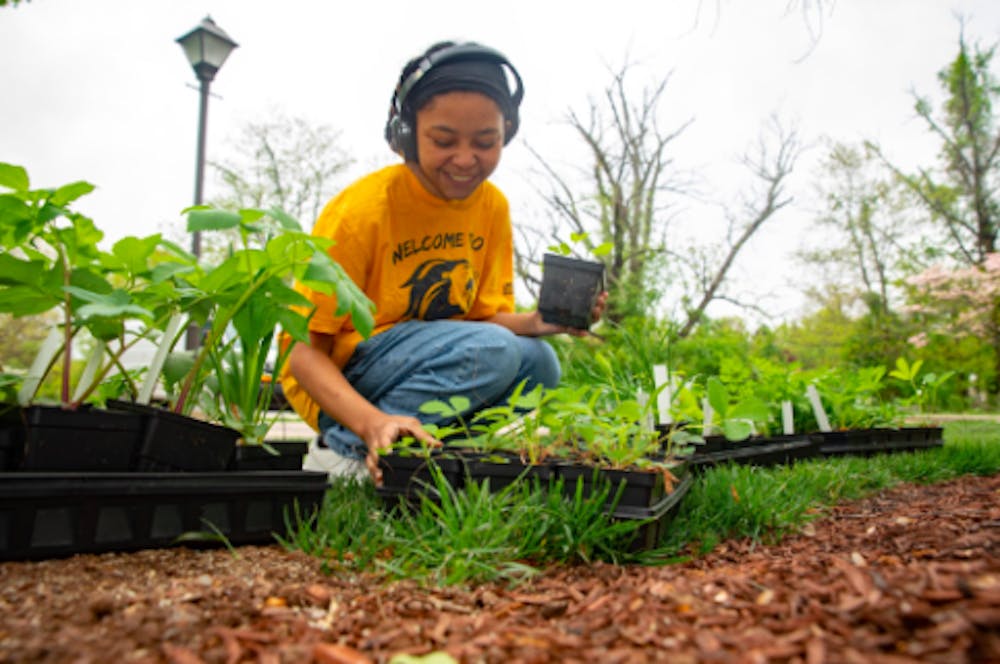By Parisa Burton
Staff Writer
The elementary and early childhood education department, environmental sustainability education committee and the Bonner Institute came together on April 28 to bring life to the new outdoor classroom on campus.
The environmental sustainability education committee was able to reserve a spot outside of the school of education for the new outdoor classroom. Bonner volunteers came to help set the plan in motion by planting beautiful native plants in the set space.
“As we went through the pandemic many schools started to have classes outside,” said Louise Ammentorp, professor of elementary and early childhood education. “In the summer of 2020 I had the idea of having an outdoor classroom. With a lot of negotiation and support of the Dean Suzanne McCotter, and the help of the committee we worked hard to make it happen.”
The goal of the classroom is to bring students together in a beautiful space while educating them about the biodiversity surrounding them.
“We want to use this as an educational space about the importance of native plants and biodiversity and just a beautiful space to learn,” Ammentorp said. “It’s important to us that students can go outside to learn.”
The funding for the outdoor classroom came from the late College alumna Marilyn Grinwis Gray. The classroom is dedicated to her in recognition and appreciation for her generous contributions to the School of Education.
“Marilyn was born in 1927 and graduated from the College in 1948 with a degree in early childhood education,” said Director of Development and Planned Giving Jim Spencer. “She passed away in February of 2015. She was a retired music teacher and kindergarten teacher.”
Gray was a member of the College’s Heritage Society, which recognizes individuals who have made planned gifts, like Gray, by leaving money in their retirement or investment account. Her gift to the College was recognized by the Board of Trustees in 2012 by naming the early childhood classroom in the School of Education building in her honor.
“Funding for the new outdoor classroom was made feasible by the endowment funds created by Marilyn,” Spencer said.
Windpipes will also be installed in the outdoor classroom to honor Gray’s love for music.
In order to attract biodiversity, native plants like strawberries, nettle, virginia rose and a medicinal herb called Angelica were planted. The plants chosen will attract butterflies, hummingbirds and insects. Little signs will stand by each plant telling people exactly what they are.
Miriam Shakow, professor of anthropology, noted that many people don’t realize how fundamental biodiversity is to humans.
“A third of our food goes away without pollinating insects and bugs that do all kinds of things to enrich the soil and decompose stuff,” Shakow explained. “Scientists have noticed a huge crash in the insect and bird population partly because they are not adapted to plants that are from elsewhere. These creatures depend on native plants, which is why it’s critically important to plant as many as we can to support as much life as possible.”
This has been a long process to set in motion, starting in the fall and everything from the benches surrounding the classroom space to the rocks was a challenge to acquire.
Ammentorp spearheaded a lot of the work and then went on sabbatical, so Marissa Bellino, an associate professor of education, took over as the coordinator for the environmental sustainability education committee.
According to Bellino, the professors have been in conversation with the College’s facilities and architecture departments and really struggled with getting benches, because the vendors they were using were very overpriced. They then had the idea of repurposing benches already on campus, which was the most sustainable option.
“It was a collaboration between the architect, Louise Ammentorp, myself and Miriam Shakow,” Bellino said.
According to Ammentorp, the outdoor classroom will resemble a living lab. People can use it as an educational space but it will also attract butterflies and beneficial insects. There are not a lot of gardens on campus as it’s mostly grass, so this space will bring color and livelihood to the college.
The educational aspect of this outdoor classroom is a critical part of its purpose.
“It’s a crime that all of us are raised without understanding that the world we depend on requires us to plant native plants and make sure they thrive,” Shakow said. “We’re raised in a way that doesn’t support our own health, yet alone other living creatures' health.”
Though upkeep is a pressing concern, planning is still underway and maintenance should not be an issue.
“A lot of the plants we got don’t require a lot of maintenance and will be pretty self-sufficient, so it will not be a mess,” Ammentorp explained. Shakow added that Bonner Community Scholars that need volunteer hours will do weeding, and interested faculty will also help with upkeep.
The new classroom will offer students a variety of health and wellness benefits.
“Studies have shown that being around trees is good for our health,” Shakow said. “By having this space, students can be surrounded by trees in class. It can be used as an outdoor classroom or informally to hangout with friends.”







